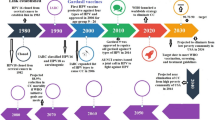Abstract
This study was undertaken to assess the rate of HPV infection in cervical carcinoma among southern Iranian patients. 101 archival cervical carcinoma tissue samples of a 10 year period were studied for the presence of HPV DNA in southern Iran by a polymerase chain reaction method. In addition, the presence of high risk HPV-16 and HPV-18 genotypes was investigated. In total, 88 (87.1%) of the samples were HPV DNA positive, of which 83 were squamous cell carcinomas and 5 were adenocarcinomas. HPV-16 genotype was detected in 26.7% of HPV positive cervical carcinomas; however none of the samples were positive for the existence of HPV-18 genotype. Collectively, these results suggest that HPV-16 and HPV-18 are not the frequent high risk HPV types in our patients and circulating HPV types in southern Iranian population are different from many other populations.
Similar content being viewed by others
References
Parkin DM: Global cancer statistics in the year 2000. Lancet Oncol 2:533–543, 2001
Farahmandbeigi M, Kadivar MR: The incidence rate of registered cancer in Fars province. Disease Control Unit, Shiraz University Press, Iran, 2000
Bosch FX, Munoz N. The viral etiology of cervical cancer. Virus Res 89:183–190, 2002
Walboomers JM, Jacobs MV, Manos MM, et al. Human papillomavirus is a necessary cause of invasive cervical cancer worldwide. J Pathol 189:12–19, 1999
Southern SA, Herrington CS. Disruption of cell cycle control by human papillomaviruses with special reference to cervical carcinoma. Int J Gynecol Cancer 10:263–274, 2000
Park TW, Fujiwara H, Wright TC. Molecular biology of cervical cancer and its precursors. Cancer 76:1902–1913, 1995
IARC working Group, Human papilloma viruses, IARC Monograph on the evaluation of carcinogenic risks to humans. Lyon, France: International Agency for Research on Cancer, 65, 1995
Badaracco G, Venuti A, Sedati A, Marcante ML. HPV16 and HPV18 in genital tumors: Significantly different levels of viral integration and correlation to tumor invasiveness. J Med Virol 67:574–582, 2002
Munoz N, Franceschi S, Bosetti C, et al. International Agency for Research on Cancer. Multicentric Cervical Cancer Study Group Role of parity and human papillomavirus in cervical cancer: the IARC multicentric case-control study. Lancet 359:1093–1101, 2002
Castle PE, Wacholder S, Lorincz AT, et al. A prospective study of high-grade cervical neoplasia risk among human papillomavirus-infected women. J Natl Cancer Inst 94:1406–1414, 2002
Rong S, Chen W Wu L, et al. Analysis of risk factors for cervical cancer in Xiangyuan County, Shanxi Province Zhonghua Yu Fang Yi Xue Za Zhi 36:41–43, 2002
Mandelblatt JS, Lawrence WF, Womack SM, et al. Benefits and costs of using HPV testing to screen for cervical cancer. JAMA 287:2372–2381, 2002
Castellsague X, Menendez C, Loscertales MP, et al. Human papillomavirus genotypes in rural Mozambique. Lancet 358:1429–1430, 2001
Snijders PJ, van den Brule AJ, Schrijnemakers HF, et al. The use of general primers in the polymerase chain reaction permits the detection of a broad spectrum of human papillomavirus genotypes. J Gen Virol 71:173–181, 1990
Samoylova EV, Shaikhaiev GO, Petrov SV, et al. HPV infection in cervical cancer cases in Russia. Int J Cancer 61:337–341, 1995
Ferenczy A, Franco E. Cervical-cancer screening beyond the year 2000. Lancet Oncol 2:27–32, 2002
Sebbelov AM, Davidson M, Kruger Kjaer S, et al. Comparison of human papillomavirus genotypes in archival cervical cancer specimens from Alaska natives, Greenland natives and Danish Caucasians. Microbes Infect 2:121–126, 2000
Goncalves MA, Massad E, Burattini MN, Villa LL. Relationship between human papillomavirus (HPV) genotyping and genital neoplasia in HIV-positive patients of Santos City, Sao Paulo, Brazil. Int J STD AIDS 10:803–807, 1999
Lo KW, Wong YF, Chan MK, et al. Prevalence of human papil-lomavirus in cervical cancer: a multicenter study in China. Int J Cancer 100:327–331, 2002
Baay MF, Tjalma WA, Weyler J, et al. Human papillomavirus infection in the female population of Antwerp, Belgium: prevalence in healthy women, women with premalignant lesions and cervical cancer. Eur J Gynaecol Oncol 22:204–208, 2001
Chen S, O’Sullivan H, Tabrizi SN, et al. Prevalence and genotyping of HPV in cervical cancer among Australian women. Int J Gynaecol Obstet 67:163–168, 1999
Chabaud M, Le Cann P, Mayelo V, et al. Detection by PCR of human papillomavirus genotypes in cervical lesions of Senegalese women. J Med Virol 49:259–263, 1996
Bestow AH, Gyllensten UB. Host genetic control of HPV 16 titer in carcinoma in situ of the cervix uteri. Int J Cancer 101:526–531, 2002
Zwaveling S, Ferreira Mota SC, Nouta J, et al. Established human papillomavirus type 16-expressing tumors are effectively eradicated following vaccination with long peptides. J Immunol 169:350–358, 2002
Dehaghani AS, Amirzargar A, Farjadian S, Ghaderi A. HLA-DQB1 alleles and susceptibility to cervical squamous cell carcinoma in Southern Iranian patients. Pathol Oncol Res 8:58–61, 2002
Amirzargar A, Mytilineos J, Farjadian Sh, et al. Human Leukocyte Antigen class II allele frequencies and haplotype association in Iranian population. Hum Immunol 62:1234–1238, 2001
Hording U, Teglbjaerg CS, Visfeldt J, Bock JE. Human papil-lomavirus types 16 and 18 in adenocarcinoma of the uterine cervix. Gynecol Oncol 46:313–316, 1992
Bjersing L, Rogo K, Evander M, et al. HPV 18 and cervical adenocarcinomas. Anticancer Res 11:123–127, 1991
Author information
Authors and Affiliations
Corresponding author
Rights and permissions
About this article
Cite this article
Farjadian, S., Asadi, E., Doroudchi, M. et al. High risk HPV types in southern Iranian patients with cervical cancer. Pathol. Oncol. Res. 9, 121–125 (2003). https://doi.org/10.1007/BF03033756
Received:
Accepted:
Issue Date:
DOI: https://doi.org/10.1007/BF03033756




